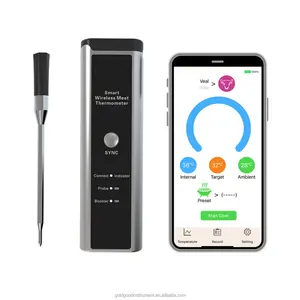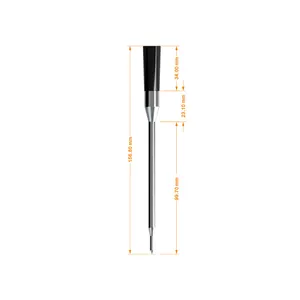
All categories
Featured selections
Trade Assurance
Buyer Central
Help Center
Get the app
Become a supplier

(1883 products available)









































One of the main tools that candy makers require is a candy thermometer. Several thermometers are available that operate on various fundamental principles and serve diverse purposes. Below is a list of the most popular types of candy thermometers:
Digital candy thermometers are popular because they provide quick and accurate temperature readings. A sensor at the end of the probe collects the temperature data and shows it on a digital display. Because the results are quick and the display is instant, there is a lesser risk involved in making candy, especially at high temperatures. Some types also come with temperature alarms for certain levels. Therefore, digital thermometers are not just about speed; they add some degree of safety to the candy-making process.
Dial thermometers, or analog thermometers, measure temperature using glass mercury or alcohol columns, which appear on a dial or gauge. Although not as precise, dial thermometers were used because of their broad measurement range. Thermometers with clamps can be attached to the side of a saucepan to stabilize the probe during use. While it may take longer for dial candy thermometers to measure temperatures, they remain a staple in many kitchens because of their fundamental effectiveness.
Infrared candy thermometers work well because they measure temperature without touching the object, which is known as a non-contact measurement. In this type, a lens focuses the heat emitted by an object onto a detector called a thermopile, which converts the heat into an electric signal, allowing the temperature of the object to be calculated. This is useful for measuring the temperature of candy on a baking sheet or in a pot without directly inserting a probe. They are particularly useful in situations where contact with food is not allowed or when trying to maintain a safe distance from extremely hot candy.
Tube thermometers are another candy thermometer that uses a liquid column in a glass tube to measure temperature. The liquid expands and rises within the tube as the temperature increases, marking the measurement on a dial that is located outside the tube. A clip holds the probe to the pot's side, ensuring contact with the candy. Tube thermometers are ideal for measuring caramel or toffee temperature during candy-making because they can measure high temperatures.
Candy thermometers include some critical features that allow more effective temperature measurement in candy making. The proposed features guarantee accuracy, safety, and convenience, all of which are essential for candy making:
The measurement range is one of the important aspects of a candy thermometer. A good candy thermometer should withstand the heat needed for candy, ideally anywhere from 230 to 320 degrees Fahrenheit. Any higher, and it will lose the ability to measure accurately, and any lower, and it won't be able to measure the temperatures of hard candies or caramel. Extended ranges give versatility when different types of candy are made.
The candy thermometer's material must be heat-resistant since the gadgets come in touch with very hot liquids. Most metal probe models are constructed with stainless steel, which does not warp at high temperatures and is very heat- and rust-resistant. Glass thermometers are reasonably hardy, but in case they break, they might be a danger in a hot environment. Protective metal casing around the internal components enhances their strength.
A stable thermometer is vital for correct readings: even a small movement can change the temperature readings and cause a disaster in candy-making. Most models supplied with a clip are made to attach the thermometer to the side of the saucepan to ensure that the probe tip is correctly positioned in the liquid. The clip helps maintain this steady position and eliminates the need for constant monitoring during the cooking process.
Precision is always important in candy making: just a few degrees off can cause the difference between soft caramel and hard toffee. Good candy thermometers can measure from +/-1 to 2 degrees Fahrenheit. Many digital models have pre-set calibration levels for increased measurement accuracy. Candy makers are thankful for this feature, which reduces the margin for error.
Regarding usability, the kind of display that shows the temperature is also important. Digital thermometers give the temperature instantly on a screen, eliminating the need for the cook to look at the dial. The 'hold' feature allowed the last contacted temperature to be preserved, making it very useful when the chef had to check the temperature threshold quickly without wandering around.
Most candy thermometers work well in home kitchens, but some advanced or specialized models are used commercially. Here are some ways a candy thermometer is used in the manufacturing environment:
The candy industry requires a thermometer for precision candy production, such as hard candy, lollipops, or gummies. In these processes, the temperature of the sugar syrup must be controlled to ensure that the final product has the right texture and hardness. Candy thermometers are used in this large-scale production process, and commercial-grade devices withstand frequent use with higher accuracy and stability. In candy manufacturing, small temperature variations can change the product's consistency, so precision is important.
Temperature also plays a big role in sugar work in commercial bakeries and pastry shops. Caramel, meringue, and toffee require careful temperature control to achieve the right texture and consistency for candies and desserts. Pastry chefs use candy thermometers to ensure that their sugar syrups are at the right temperature for caramel sauces, sugar decorations, and other desserts. Without precise temperature control, the success of these complex and delicate recipes would be in jeopardy.
Food packaging facilities use a candy thermometer to ensure any candy products that are packaged are at safe temperatures. This is an important food safety step since packaging candy that has not cooled down completely can lead to condensation within the package. Excess condensation carries the risk of mold or the package being damaged. Packaging facilities use thermometers to monitor and maintain temperature during processing to avoid such problems and ensure the product's quality and safety.
Candy stores, where candy is made on-site, also need reliable candy thermometers. Many stores make gourmet candy, toffee, and brittles, requiring accurate temperature measurements for quality-controlled candy. A candy thermometer is an important tool for both the chef and the craftsman in candy shops, helping to ensure that each batch of candy is made with the same care, safe temperature measurement, and time-honored precision.
Temperature is the main aspect of candy making, and candy thermometers are used to measure that temperature. There are different kinds of candy thermometers on the market today. Therefore, one must consider the following before purchasing a candy thermometer:
In candy making, accuracy is critical since even a small variation can lead to a mess. Precision is needed when working with the soft ball stage and other stages of candy making. Another factor is the measurement range: make sure the thermometer can go up to hotter temperatures, such as those needed for caramels or hard candies. Opt for a thermometer with a wide range and a high degree of accuracy for the best results.
The type and readability of the candy thermometer are among the main considerations. Digital thermometers provide instant readings with the temperature displayed on the screen, which eliminates the need to look closely and reduces placement errors. At the same time, some people prefer dial thermometers with a big face because they can turn the dial with their hands. The other key aspect is the quality of the display: ensure that the numbers are readable and there are no reflections or glare when looking at the device.
Another important aspect is stability: temperature readings should be stable for their entire period of cooking. Candy thermometers usually come with a clip that attaches to the side of a saucepan to prevent movement. Ensure the clip is sturdy, well-designed, and holds the thermometer firmly without slipping. If choosing a probe model, check its length to ensure that the tip reaches the pot's bottom and does not touch the sides.
Finally, consider factors like ease of use and cleaning. Many digital models are fitted with a calibration preset to make them easy to use. Cleaning can also be a concern: if a probe is inserted into a pot, it might need to be cleaned after each use, but some models are dishwasher safe. Consider how much time will be spent on maintenance after each use and the usability offered by the model chosen.
A1: Look for thermometers with an accuracy of +/- 1 to 2 degrees Fahrenheit. Higher precision is better when making candies, as small temperature changes can affect the results.
A2: Yes, a digital probe thermometer works well for candy making. The probe gives instant readings, and the digital screen clearly shows the temperature, which helps control temperatures for caramel and hard candies.
A3: Yes, a candy thermometer can measure temperatures for deep frying too. As long as the thermometer can reach around 350 to 375 degrees, it will work well for frying foods safely without losing the oil's heat.
A4: To prevent touching, the probe must be long enough to reach the bottom without touching the sides of the pan. For best results, choose a thermometer with a clip to hold it in place at the center.
A5: To keep the thermometer working well, keep it clean and prevent exposure to extreme temperatures. Make sure the probe is in good condition and avoid bending it. Calibrating it regularly will ensure accurate results each time it's used.